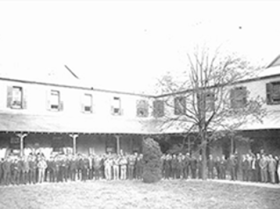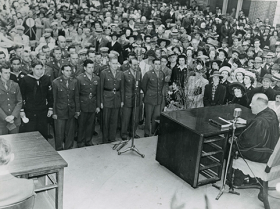Stories from the Archives
Read the stories of people and programs that make up federal immigration history, learn about the most interesting items in our library collection, or get tips on researching in agency records.
Type a topic or time period into the “Search by Content” box below or browse through the articles.
Among the most important of USCIS’s missions is promoting citizenship instruction and fostering civic assimilation. Today the agency accomplishes this mission through a variety of print, multimedia, and digital resources, such as the online Citizenship Resource Center. USCIS’s current efforts follow a long history of Immigration and Naturalization Service (INS) citizenship awareness campaigns.
It’s a little-known fact that the Bureau of Immigration played a key role in the U.S.’s first act of World War I.
In January 2023, USCIS released a redesigned Permanent Resident Card or “Green Card.” This design contains state-of-the-art technology, including holographic images and optically variable ink. Visually, this Green Card retains much of the previous version’s design (PDF, 1.69 MB), which also featured a red, white, and blue flag on a green background.
The Certificate of Naturalization is perhaps the most important of the three naturalization records usually found in U.S. Citizenship and Immigration Services’ (USCIS) historic Certificate Files (“C-Files”) because Certificates of Naturalization help protect naturalized persons’ rights as U.S. citizens and the U.S. government from false claims to American citizenship. This study surveys the development of Certificates of Naturalization during the first half of the 20th Century.
As the American military mobilized to enter World War I in 1917, its ranks filled with a cross-section of American society, including immigrants from around the world.
When Congress created the U.S. Immigration Bureau in 1891, few women had the right to vote, and many people believed a woman’s place was in the home. In 1893, only 16 women worked for the immigration service, most as cleaners and laundrywomen. Fast forward more than 130 years and approximately 55% of the agency’s workforce are women. In 2021, Ur Mendoza Jaddou was confirmed by the senate to become USCIS’ first permanent female director.
Reasons That Some C-Files Do Not Include a Declaration of IntentionUSCIS Genealogy records requesters sometimes discover the Certificate File ("C-File") they received does not contain a Declaration of Intention record. The Declarations are not missing. Rather, these C-Files usually document “one-paper” naturalizations (so called because only a Petition for Naturalization was filed).
After the United States entered the First World War, Congress passed the Naturalization Act of May 9, 1918, to expedite naturalization for alien members of the U.S. armed forces. Congress wanted to reward foreign-born service members and encourage immigrant enlistments.
After the United States entered World War II Congress acted to provide for the expedited naturalization of aliens serving honorably in the U.S. Armed Forces.
In November 1956, a failed revolt against Communism in Hungary spurred the greatest refugee crisis in Europe since the end of World War II. President Dwight D. Eisenhower and his administration, including the Immigration and Naturalization Service (INS), moved swiftly in response. Through the hard work of INS employees as well as the State Department, the military, and civilian volunteers, over 30,000 refugees resettled in the United States over an eight-month period. The success of “Operation Safe Haven”, set a precedent for the U.S.









